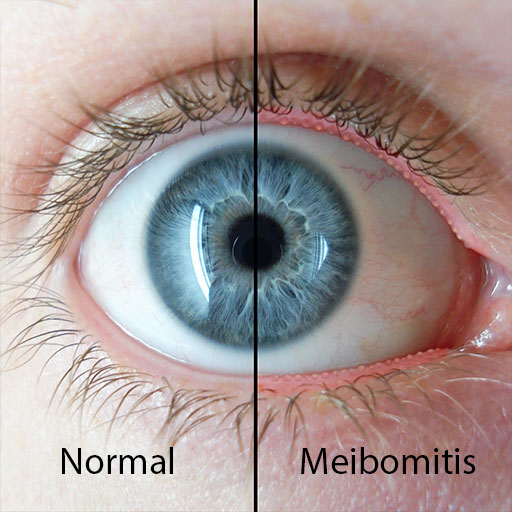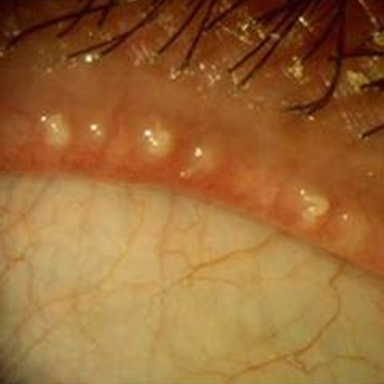Overview
The Meibomian glands are composed of acinar cells connected to a central duct, which opens onto the mucocutaneous junction at the lid margin. Lipids slowly emerge from this orifice throughout the day and night, but the pressure of Riolan's muscle contracting with the blink causes the most considerable release. The lower lid houses about 20 to 25 glands while the longer, upper lid accommodates 30 to 40, each about 1 mm wide and 3 to 12 mm long.
Meibomitis is typically an Inflammation of the small glands that produce this oily component of the tearlayer that keeps the eye moist and lubricated when we blink, or for the rotation of the eyeball while looking in different directions. Typical Symptoms are red eye, excessive watering blurry vision, dry eye, and swollen lids. Blepharitis and meibomitis usually occur together, and then the symptoms are more severe. Treatment is typically nightly warm compress, Lid scrubs and ointment. Drops to relieve symptoms, and where necessary antibiotic tablets or eyedrops are also often indicated. This condition is also referred to as meibomian gland dysfunction
Signs and Symptoms
People with Meibomitis (known also as Posterior Blepharitis) complain of chronic sandy-gritty eye irritation. But in these people, the irritation is worse upon awakening because the inflammation is in the eyelids. During sleep, tear production decreases, eye closure brings the inflamed lids right up against the eye, and the released inflammatory mediators act on the cornea all night, creating a symptom peak upon eye opening. When these people awake, tear flow increases, the lids pull away from the cornea, and their symptoms improve as the day goes on.
Eventually the chronic meibomian gland inflammation leads to meibomian gland dysfunction. When that happens, these patients develop a second peak in symptoms from dryness toward the end of the day. Finally, when the meibomian gland inflammation and secondary healing obliterate the meibomian glands, the morning symptoms resolve and patients are left with symptoms from dryness alone, with sandy-gritty irritation that gets worse as the day goes on.
Symptoms may vary, but the most common are
- Red eye
- Red eyelid margins
- Watery eye
- Dry eye
- Itching
- Burning eye
- Blurry vision
- Foreign Body Sensation
- Light sensitivity (especially in the morning hours)
Causes and Risks
When a patient is affected by an inflammation the produced oil is less in quantity and worse in quality as a result quicker tear evaporation. In addition, these oils become stagnant and bacteria, usually staph bacteria, colonize inside the meibomian glands. Moreover, these bacteria produce toxins that cause the lids to become red and inflamed. The symptoms are different for each patient but most of the times are similar to common blepharitis.
The most common causes of Meibomianitis are
- Allergies
- Hormonal changes associated with adolescence
- Skin conditions, such as rosacea, acne or scalp dandruff
- Eyelash mites or lice
- Medications that increase bacteria on the eyelids, including isotretinoin for acne
- Some contact lens solutions
- Eye make-up
- Poor eye hygiene
- Poor nutrition
- Compromised immunity
Stats and Incidence
Meibomian gland dysfunction is a relatively common affliction, and may present in upwards of 60 percent of dry-eye sufferers.
Meibomitis's etiology remains unknown, there's no universal definition or classification for it, and it has no proven treatment. Many theories exist as to its causes, though most studies haven't been replicated and have used different scales and methodologies. As many ideas are in debate, a multidisciplinary approach to understanding meibomian gland dysfunction and disease is merited. Given that the meibomian gland is a modified sebaceous gland, the intricate interlacing’s of human biological systems suggest that an interdisciplinary perspective of gland dysfunction in related fields could be of benefit to practitioners.
Treatment
The most successful treatments of Meibomianitis consists of
- Warm therapy first thing in the morning by applying a clean, hot towel, or facecloth for 10 minutes on the eyelids. This warming of the eyelids will help the oil in the glands to flow more easily.
- Massaging your eyelids will also help oil to flow more easily. The efficiency of this treatment is increased if applied after warm therapy.
- Lid Hygiene is essential for patients who have been diagnosed with meibomitis. Many cleaning solutions exist for the eyelid margins and eyelashes. The best way to clean your eyes is by using a specialized eyelid cleanser as recommended by your eyecare practitioner. Close your eyes, clean and massage the skin over the eye area every morning for 30 seconds.
- Oral antibiotics can be prescribed, to not to kill the bacteria but to increase the quality of the oil. Antibiotic treatment might last several months. Only your doctor can prescribe antibiotics.
- Recent research proved that omega 3 acids diet help meibomian oil to restore its quality and stabilize inflammation. Alternatively, for high efficiency and quick result, there is the option to buy omega-3 supplements.
- Topical Steroids can be used in severe cases to reduce the inflammation and protect the eye from damage.
- Vitamin C and A

